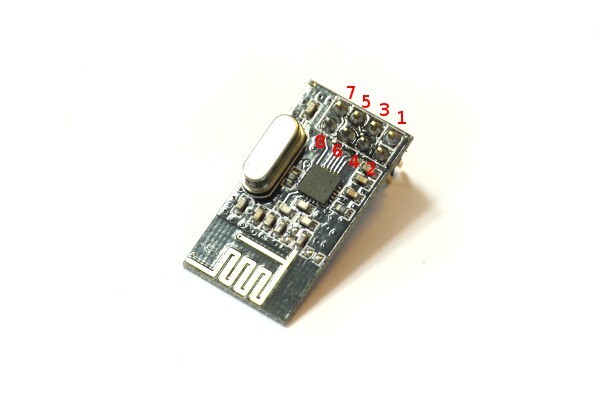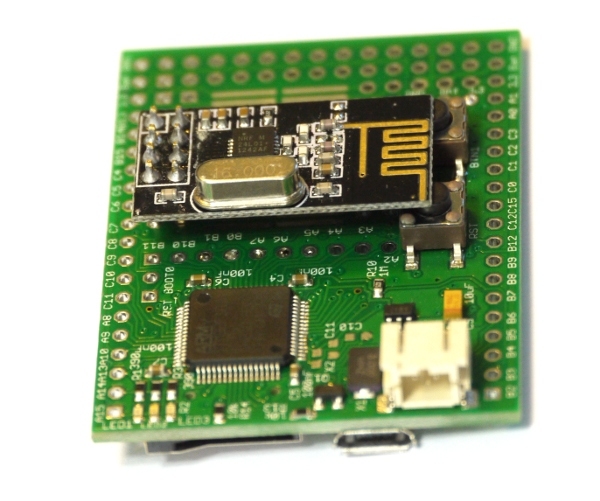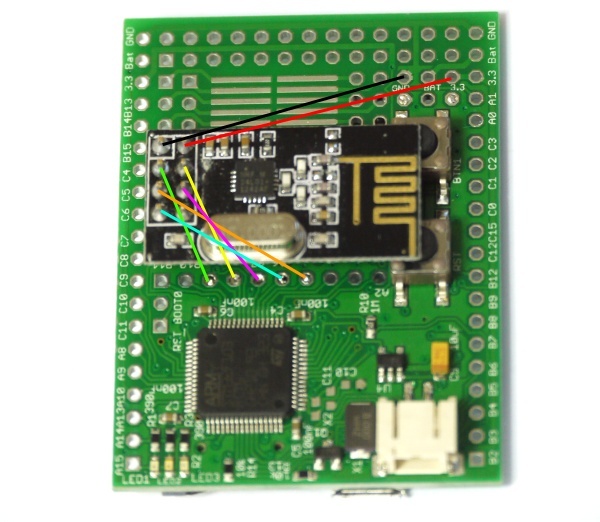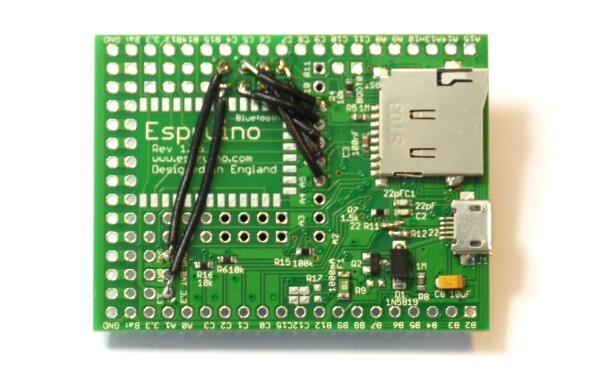NRF24L01+ Wireless Module


The Nordic NRF24L01+ transceiver is very popular and works well with Espruino. It is sold in very inexpensive wireless modules that interface via SPI. They can easily be obtained via eBay and many other places for prices as low as $2.
A driver for it is available in the NRF24L01P (About Modules) module.
Connect as follows:
| NRF24L01+ | Name | Espruino Original | Type |
|---|---|---|---|
| 1 | GND | GND | GND |
| 2 | 3.3V | 3.3 | 3.3v |
| 3 | CE | B1 | GPIO Out |
| 4 | CSN | B0 | GPIO Out |
| 5 | SCK | A5 | SPI SCK |
| 6 | MOSI | A7 | SPI MOSI |
| 7 | MISO | A6 | SPI MISO |
| 8 | IRQ | unused | GPIO In |
Note: These pins are suggested for the Original Espruino Board as they are in the middle, leaving the edges free for IO. However you can use any GPIO pins you want (with software SPI you needn't use SPI pins either).
For the Pico there is an adaptor shim available as part of the shim collection that makes the NRF24 a lot easier to solder!
We'd also suggest that you add a 10nF - 100nF decoupling capacitor between GND and 3.3v. Some cheaper modules can be unrelible without this.
You can either connect the module with wires and mount it separately, or you can solder it into the prototype area, and run wires as follows on the back of the board. We'd recommend using thin, solid core wire for this.

The finished wiring might look like this:

Notes
- The NRF24L01+ is a packet radio. It can transmit and receive small packets (up to 32 bytes) of data
- Devices have a transmit and a receive address
- Devices can only transmit or receive. They can't do both at the same time
- Transmits are acknowledged - a module knows if the data it sent was received
- The NRF24 module can be unreliable at the higher
The Espruino module allows you to send and receive strings. It does this by sending enough packets to contain the string plus a terminating zero. It will retry, but it is possible for parts of the string to get missed out.
Simple Usage
We've made simple handlers that allow you to send commands, receive data, and even reprogram a device...
Just do the following for a Slave:
SPI1.setup({sck:A5, miso:A6, mosi:A7});
var nrf = require("NRF24L01P").connect( SPI1, B0, B1 );
function onInit() {
nrf.init([0,0,0,0,1], [0,0,0,0,2]);
}
onInit();
setInterval(function() {
nrf.slaveHandler();
}, 50);
And the following for a Master:
SPI1.setup({sck:A5, miso:A6, mosi:A7});
var nrf = require("NRF24L01P").connect( SPI1, B0, B1 );
function onInit() {
nrf.init([0,0,0,0,2], [0,0,0,0,1]);
}
onInit();
setInterval(function() {
nrf.masterHandler();
}, 50);
Note the two addresses that are given to init - one is the transmit address, one is a receive address. We also use the onInit function, which is called automatically by Espruino when it starts up.
On a Master all you have to do is use nrf.sendCommand to send a command to the Slave Espruino, and in a few milliseconds the result will appear:
nrf.sendCommand("1+2", function(r) { print("=="+r); });
=3
nrf.sendCommand("analogRead(A0)", function(r) { print("=="+r); });
=0.356694
nrf.sendCommand("LED2.set()", function(r) { print("=="+r); });
=undefined
You can even reprogram the Espruino wirelessly!
nrf.sendCommand("function on() { LED3.set(); }");
nrf.sendCommand("on();");
To communicate with another Espruino, all you need to do to is to call nrf.setTXAddr([1,2,3,4,5]) on the master, giving the address that you have to the Slave Espruino's nrf.init function.
Advanced Usage
The usage of slaveHandler and masterHandler is not required - if you want, you can call methods such as send and getDataPipe() directly. For instance you could make a simple wireless sensor:
SPI1.setup({sck:A5, miso:A6, mosi:A7});
var nrf = require("NRF24L01P").connect( SPI1, B0, B1 );
function onInit() {
nrf.init([0,0,0,0,1], [0,0,0,0,2]);
}
onInit();
setInterval(function() {
var value = analogRead(A0); // read a value in
nrf.sendString(""+value);
}, 5000);
And then a receiver:
SPI1.setup({sck:A5, miso:A6, mosi:A7});
var nrf = require("NRF24L01P").connect( SPI1, B0, B1 );
function onInit() {
nrf.init([0,0,0,0,2], [0,0,0,0,1]);
}
onInit();
dataLine = "";
setInterval(function() {
while (nrf.getDataPipe() !== undefined) {
var data = nrf.getData();
for (var i in data) {
var ch = data[i];
if (ch===0 && dataLine!=="") {
console.log(dataLine);
// we could even save it onto an SD card using require('fs').appendFile("log.txt", dataLine+"\n");
dataLine = "";
} else if (ch!==0) {
dataLine += String.fromCharCode(ch);
}
}
}
}, 50);
More Advanced Usage
You can send individual packets using NRF.send(data), where data is an array of numbers of length NRF.PAYLOAD. To receive you can use the same NRF.getData() function. For more information consult the module (NRF24L01P (About Modules)).
Reference
// Initialise the NRF module. Takes a 5 byte array for both RX and TX addresses
NRF.prototype.init = function (rxAddr, txAddr) { ... }
// Set whether the NRF module is enabled
NRF.prototype.setEnabled = function (isEnabled) { ... }
// Set an register (for internal use only)
NRF.prototype.setReg = function (reg, value) { ... }
// Set an address (for internal use only)
NRF.prototype.setAddr = function (reg, value) { ... }
// Set receive address (a 5 byte array). Optional pipe argument. Note that pipes>1 share pipe 1's last 4 address digits
NRF.prototype.setRXAddr = function (adr, pipe) { ... }
// Set the transmit address (a 5 byte array)
NRF.prototype.setTXAddr = function (adr) { ... }
// Get the value of the given register (for internal use only)
NRF.prototype.getReg = function (reg) { ... }
// Get the configured address. reg should be NRF.C.TX_ADDR,C.RX_ADDR_P0..4
NRF.prototype.getAddr = function (reg) { ... }
// Get the contents of the status register
NRF.prototype.getStatus = function () { ... }
// Set the data rate, Either 250000, 1000000 or 2000000
NRF.prototype.setDataRate = function (rate) { ... }
// Set the transmit power - takes a value from 0 (lowest) to 3 (highest)
NRF.prototype.setTXPower = function (pwr) { ... }
// Set RF channel, from 0 to 125
NRF.prototype.setChannel = function (channel) { ... }
NRF.prototype.disableCRC = function () { ... }
NRF.prototype.setAutoAck = function (enable) { ... }
// return undefined (if no data) or the pipe number of the data we're expecting
NRF.prototype.getDataPipe = function () { ... }
// If there is data available, return an array if PAYLOAD size containing it
NRF.prototype.getData = function () { ... }
// Send a single packet (of length PAYLOAD). Returns true on success
NRF.prototype.send = function (data) { ... }
// Slave handler - for slaves this should be called roughly every 50ms
NRF.prototype.slaveHandler = function () { ... }
// Master handler - for masters this should be called roughly every 50ms
NRF.prototype.masterHandler = function () { ... }
// Send a string in one or more packets. Returns true on success
NRF.prototype.sendString = function (cmd) { ... }
// Send a command as a master. The callback is then called when data is received back. Returns true on success
NRF.prototype.sendCommand = function (cmd, callback) { ... }
// Create a new NRF class
exports.connect = function (_spi, _csn, _ce, _payload) { ... }
Using
Buying
NRF24L01+ modules are usually based on Nordic's own reference design, so can be purchased from many places:
This page is auto-generated from GitHub. If you see any mistakes or have suggestions, please let us know.
